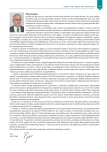-
Medical journals
- Career
Diabetes mellitus and lipid metabolism
Authors: Viliam Mojto
Authors‘ workplace: III. interná klinika LF UK a UN Bratislava, Nemocnica akademika Ladislava Dérera
Published in: AtheroRev 2016; 1(2): 69-73
Category: Reviews
Overview
Diabetes mellitus is one of the most important risk factors for cardiovascular diseases. The risk is increased in presence of dyslipidemia. Diabetic dyslipidemia consists of elevation of triacylglycerols, low levels of HDL-cholesterol and elevation of LDL cholesterol. Defects in insulin action and hyperglycemia could lead to dyslipidemia. In the case of DM2, the obesity and insulin-resistant state lead to lipid abnormalities independently of hyperglycemia. In poorly controlled DM1 hypertriacylglyceridemia and reduced HDL-cholesterol commonly occur. Insulin controlled apoprotein production in the liver, regulation of lipoprotein lipase, actions of cholesteryl ester transfer protein and peripheral actions of insulin on adipose tissue and muscles are considered to be important mechanisms responsible for diabetic dyslipidemia. High intensive therapy of diabetic dyslipidemia will clearly reduce the risk of cardiovascular diseases in patients with DM.
Key words:
diabetes mellitus – ezetimib – fibrates – HDL-C – hypertriacylglycerolemia – small-dense LDL – statins
Sources
1. Lipid management. In: ADA. Standards of medical care in diabetes – 2016. Diabetes Care 2016; 39(Supl.1): S63-S66. Dostupné z WWW: <http://care.diabetesjournals.org/site/misc/2016-Standards-of-Care.pdf>.
2. Rašlová K. Diabetes mellitus a dyslipoproteinémia. Diabetológia Obezitológia 2014. Odborná príloha časopisu Bedeker zdravia: 17–20. Dostupné z WWW: <http://bedekerzdravia.sk/domains/bedekerzdravia/UserFiles/Files/diabetologia14_web.pdf>.
3. Parhofer KG. Pathophysiology of diabetic dyslipidemia: implications for atherogenesis and treatment. Clin Lipidol 2011; 6(4): 401–411.
4. Mihaylova B, Emberson J, Blackwell L et al. Cholesterol Treatment Trialists’ (CTT) Collaborators. The effects of lowering LDL cholesterol with statin therapy in people at low risk of vascular disease: meta-analysis of individual data from 27 randomised trials. Lancet 2012; 380(9841): 581–590.
5. Cannon CP, Blazing MA, Giugliano RP et al. [IMPROVE-IT Investigators]. Ezetimibe added to statin therapy after acute coronary syndromes. N Engl J Med 2015; 372(25): 2387–2397.
6. Khunti K, Davies M, Majeed A et al. Hypoglycemia and Risk of Cardiovascular Disease and All-Cause Mortality in Insulin-Treated People With Type 1 and Type 2 Diabetes: A Cohort Study. Diabetes Care 2015; 38(2): 316–322.
7. Fisher M. Statins for people with type 1 diabetes: when should treatment start? Practical Diabetes 2016; 33(1): 10–11.
8. Moriarty PM, Jacobson TA, Bruckert E et al. Efficacy and safety of alirocumab, a monoclonal antibody to PCSK9, in statin-intolerant patients: design and rationale of ODYSSEY ALTERNATIVE, a randomized phase 3 trial. J Clin Lipidol 2014; 8(6): 554–561.
9. Zhang X-L, Zhu Q-Q, Zhu L et al. Safety and efficacy of anti-PCSK9 antibodies: a meta analysis of 25 randomized, controlled trials. BMC Med 2015; 13 : 123. Dostupné z DOI: <http://dx.doi.org/10.1186/s12916–015–0358–8>.
10. Ginsberg HN, Elam MB, Lovato LC et al. [The ACCORD Study Group]. Effects of combination lipid therapy in type 2 diabetes mellitus. N Engl J Med 2010; 362(17): 1563–1574.
11. Sattar N, Preiss D, Murray HM et al. Statins and risk of incident diabetes: a collaborative meta-analysis of randomised statin trials. Lancet 2010; 375(9716): 735–742.
12. Reiner Z, Catapano A, de Backer G et al. ESC/EAS Guidelines for the management of dyslipidaemias: the Task Force for the management of dyslipidaemias of the European Society of Cardiology (ESC) and the European Atherosclerosis Society (EAS). Eur Heart J 2011; 32(14): 1769–1818.
13. Taylor F, Huffman MD, Macedo AF et al. Statins for the primary prevention of cardiovascular disease. Cochrane Database Syst Rev 2013; 1: CD004816. Dostupné z DOI: <http://dx.doi.org/10.1002/14651858.CD004816.pub5>.
14. Ginsberg HN, Elam MB, Lovato LC et al. [ACCORD Study Group]. Effects of combination lipid therapy in type 2 diabetes mellitus. N Engl J Med 2010; 362(17): 1563–1574.
15. Langsjoen PH, Langsjoen JO, Langsjoen AM. Statin cardiomyopathy: the invisible pandemic. The 8th Conference of the International Coenzyme Q10 Association. October 8–11, 2015, Bologna, Italy. Programme and abstracts: WWW: <http://icqaproject.org/wp-content/uploads/2016/04/book_pagine-interne-B_N-1.pdf>: 31–32.
16. Kaila K, Haykowsky MJ, Thompson RB et al. Heart failure with preserved ejection fraction in the elderly: scope of the problem. Heart Fail Rev. 2012; 17(4–5) :555–562.
17. Pella, D. Statin intolerance – definition, pathophysiology, risk factors and management – what is the role of coenzyme Q10? The 8th Conference of the International Coenzyme Q10 Association. October 8–11, 2015, Bologna, Italy. Programme and abstracts: WWW: <http://icqaproject.org/wp-content/uploads/2016/04/book_pagine-interne-B_N-1.pdf>: 34.
Labels
Angiology Diabetology Internal medicine Cardiology General practitioner for adults
Article was published inAthero Review

2016 Issue 2-
All articles in this issue
- Editorial board
- Monoclonal antibodies in the internal medicine
- Diabetes mellitus and lipid metabolism
- Adverse metabolic effects of antihypertensive drugs. Is it clinically relevant at all?
- Secondary dislipidemia in renal disease
- Dyslipoproteinemias in endocrinopathies
- LDL-cholesterol – the main risk factor for atherosclerosis
- Alirocumab, Praluent® in the light of studies
- Athero Review
- Journal archive
- Current issue
- Online only
- About the journal
Most read in this issue- Monoclonal antibodies in the internal medicine
- Diabetes mellitus and lipid metabolism
- Alirocumab, Praluent® in the light of studies
- LDL-cholesterol – the main risk factor for atherosclerosis
Login#ADS_BOTTOM_SCRIPTS#Forgotten passwordEnter the email address that you registered with. We will send you instructions on how to set a new password.
- Career

